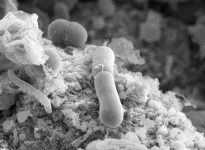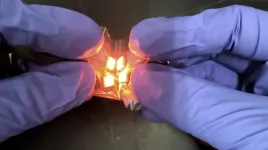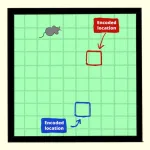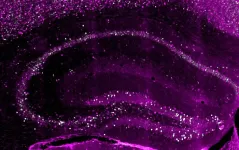(Press-News.org) WASHINGTON, D.C. – To support vulnerable communities responding to continued and extreme climate effects, the Department of Energy (DOE) today announced $10 million in funding for innovative Climate Resilience Centers (CRCs) in 10 different states. University-led research teams will leverage the world class modeling, data and research capabilities from DOE national laboratories customized for their local regions with a focus on climate prediction of weather hazard risks to better prepare communities. The CRCs are part of the Biden-Harris Administration’s Justice40 Initiative and are designed to ensure that all Americans are benefitting from scientific research.
“Every pocket of the country has experienced the impact of extreme weather events that are exacerbated by climate change, and disadvantaged communities often feel the brunt of that impact,” said U.S. Secretary of Energy Jennifer M. Granholm. “The projects announced today will leverage the world class expertise and scientific research capacities of DOE’s national laboratories to develop the tools communities will need to inform future decisions for building resiliency.
Each of the CRCs are led by Minority Serving Institutions and Emerging Research Institutions. Most are also collaborations with DOE national labs, other federal agencies, academic institutions, state and municipal agencies, or community organizations.
Projects were selected by a peer-review panel, and selections focused on a diversity of topics, regions, and institutions across the country. These projects also build on prior awards to CRCs made in 2023.
The CRCs will help form a nucleus for a diverse group of young scientists, engineers, and technicians to further their scientific research and work on scientific teams. The CRCs will also foster capacity at the regional and local level by connecting with affected communities and stakeholders to enable them to translate basic research into actionable science to enhance climate resilience, as well as to identify potential future research opportunities.
Across the 10 selectees, research projects include ways to predict and protect communities from coastal flooding and extreme storms; analyzing the impacts of drought on Tribal and agricultural communities; and improving water quality.
Selected Project Descriptions:
The 10 projects were selected under the DOE Funding Opportunity Announcement for Climate Resilience Centers DE-FOA-0003181.
The Advancing Development and Climate-Resilient Adaptation Practices via Community-Driven Urban Transformation in St. Louis, Missouri, establishes a CRC at Saint Louis University with the goal of building regional resilience to heat islands. Heat islands are urban areas that experience extreme high temperatures due to the built environment. Researchers will connect with local communities to define the impacts of climate risk; increase awareness of climate change effects; and empower communities with data to support resilience projects and green infrastructure development. The goal is improved public health, increased economic stability, and a greener infrastructure.
In the Climate Lighthouse project, City College of New York City will lead the effort partnering with the DOE’s Brookhaven National Laboratory to help residents better cope with extreme heat. The focus will be on translating DOE climate data into useable tools to improve NYC residents’ resilience. Information will be communicated to the public through community partnerships in Manhattan (Harlem) and Brooklyn. The team will work closely with community partners to improve tools so they can serve to build actionable knowledge among the public.
The goal of the CRC in Tribal communities along the Missouri River Basin is to build climate resilience capacity for Native American communities. The team effort will be led by the South Dakota School of Mines and Technology, Tribal nations, US Geological Survey, and Pacific Northwest National Laboratory (PNNL). The team will develop user-friendly planning tools to translate existing climate projections into site-specific drought and flood risks, mitigation recommendations, associated costs, and uncertainties. Educational workshops organized by the consortium will demonstrate research results.
Communities in the Texas Coastal Bend along the Gulf of Mexico face multiple water-related threats, including floods and droughts. In the Coastal Blend Climate Resilience Project, a a partnership with University of Texas-Arlington and Texas A&M University-Corpus Christi, the focus is on improving the predictions of events. The Coastal Bend CRC will use data and modeling from the DOE for adapting and planning for climate extremes. A critical part of the program is building short-and long-term capacity in communities to ensure local and community leaders can leverage climate science to inform resilience-building efforts, particularly among vulnerable groups.
The Midwest Climate Resilience Center in Clark County, Ohio, will address high risk from extreme rain and flooding and the consequential effects on drinking water quality. Central State University will partner with Ohio State University and PNNL to assess the impact of climate stressors on soil system processes in watersheds with varied land uses. The group will develop scale-appropriate targeted climate solutions for local communities and train the next generation of climate scientists from underrepresented student communities.
The Climate Resilience Center for Alaska brings together researchers from the University of Alaska Fairbanks with Los Alamos National Laboratory. As Alaska experiences transformational change due to climate warming, this funding will enhance communication with Alaska communities about existing DOE science, develop meaningful collaborations between communities and the DOE, and incorporate DOE science into educational pathways and opportunities. This project will also conduct pilot research specifically focused on southwest Alaska to demonstrate the Center’s role. Much of the research will involve graduate students supported by the Center, acting as a conduit to recruit the next generation of climate investigators, with an emphasis on rural, traditionally underserved communities.
Space Coast RESCUE (Resilience Solutions for Climate, Urbanization, and Environment) is an effort by researchers at the Florida Institute of Technology collaborating with the DOE’s Argonne National Laboratory. The Florida Space Coast, which borders the Atlantic Ocean, faces climate resilience challenges and risks that are multifaceted and representative of the problems faced by many coastal communities throughout the nation. Hazards include heat stress, extreme precipitation, tropical cyclone-induced high winds and surge, flooding, and coastal erosion, as well as inland flooding due to extreme precipitation and stormwater runoff that negatively affects water quality and human health.
Planning for extreme weather is a cornerstone of the Building Predictive Capacity to Enhance Stormwater Infrastructure and Flood Resilience project led by Central Michigan University. The project aims to produce data and tools that will help communities plan for and become more resilient to climate change in collaboration with communities in three pilot watersheds in Michigan: the Chippewa River, Lower Grand River, and Rouge River. The project will use downscaling of climate model projections to develop local precipitation models to simulate future risks of floods and torrential rains.
Powering just and resilient cities is the goal of the Gateway Cities Climate Resilience Center led by the University of Massachusetts Lowell in partnership with PNNL. The objective is to work with the community to use DOE science and tools to provide local projections of extreme temperature events. The project will assess vulnerability of residential heating and cooling power demand and potential mitigation measures in terms of urban tree cover and green spaces. Graduate students will be trained in community-engaged climate and energy-modeling research.
This project, led by Lehigh University in partnership with PNNL, will examine the impact of regional climate action plans on the response to extreme water events like floods and droughts in Eastern Pennsylvania. The team plans to work closely with the three-city coalition of Allentown, Bethlehem and Easton to address multiple climate change impacts. Community workshops will be hosted with Community Action Lehigh Valley.
Total funding for all of the projects is $10 million for Fiscal Year 2024 dollars for projects lasting three years in duration. A list of all Biological and Environmental Research (BER) projects and funding, including Climate Resilience Centers, can be found at science.osti.gov/ber.
Selection for award negotiations is not a commitment by DOE to issue an award or provide funding. Before funding is issued, DOE and the applicants will undergo a negotiation process, and DOE may cancel negotiations and rescind the selection for any reason during that time.
END
DOE announces $10 million to support climate resilience centers across America
University-led projects will share data, strengthen and build relationships between DOE and communities bearing the brunt of climate change
2024-08-15
ELSE PRESS RELEASES FROM THIS DATE:
Science in Space to Cure Disease on Earth—the International Space Station National Lab and NASA announce new funding opportunity
2024-08-15
KENNEDY SPACE CENTER (FL), August 15, 2024—The International Space Station (ISS) National Laboratory is collaborating with NASA on a solicitation for space-based research addressing some of the most significant diseases of our time—such as cancer, cardiovascular disease, and neurodegenerative disease. ISS National Lab Research Announcement (NLRA) 2024-09: Igniting Innovation: Science in Space to Cure Disease on Earth, released in partnership with NASA’s Biological and Physical Sciences division, is aimed at overcoming challenges hindering progress in disease prevention, diagnosis, and treatment. This NLRA ...
YALE NEWS: Sick days: Assessing the economic costs of long COVID
2024-08-15
A new Yale study finds that the effects of long COVID have caused many Americans to miss extensive work time, and that 14% of study participants reported not returning to work in the months after their infection.
The findings, published recently in PLOS One, suggest that long COVID may have affected millions of Americans and generated steep economic costs, highlighting the need for policies to support those with the condition, researchers said.
The study drew on a long-term survey of individuals who contracted COVID-19 — dubbed Innovative ...
Equity weighting increases the social cost of carbon, warrants careful dialogue
2024-08-15
In a Policy Forum, Brian Prest and colleagues discuss how new regulatory guidelines from the U.S. Office of Management and Budget (OMB), known as Circular A-4, could impact the social cost of carbon (SCC). The new equity weighting approach recommended by the OMB, they say, leads to a dramatic increase in SCC estimates, and thus requires careful dialogue and discussion. The social cost of carbon is an estimate of the economic damage caused by emitting an additional ton of carbon dioxide into the atmosphere. It helps guide decisions about balancing the costs of reducing emissions with the benefits of mitigating climate change. Traditionally, ...
Chicxulub impactor was a carbonaceous-type asteroid from beyond Jupiter
2024-08-15
Scientists have pinpointed the origin and composition of the asteroid that caused the mass extinction 66 million years ago, revealing it was a rare carbonaceous asteroid from beyond Jupiter, according to a new study. The findings help resolve long-standing debates about the nature of Chicxulub impactor, reshaping our understanding of Earth's history and the extraterrestrial rocks that have collided with it. Earth has experienced several mass extinction events. The most recent event occurred 66 million years ago at the boundary between the Cretaceous and Paleogene eras (K-Pg boundary) and resulted in the loss of roughly 60% of the planet’s species, including non-avian dinosaurs. ...
A role for a newly identified brain activity during sleep-dependent memory consolidation
2024-08-15
A newly identified activity in the brain that occurs while we sleep – a barrage of action potentials, or a BARR – plays a crucial role in rebalancing the hippocampal neural network during memory consolidation. The findings offer fresh insights into how our brains preserve memories while maintaining stability, as we slumber. Memory consolidation – a process that stabilizes and strengthens our recent experiences into long-term memories – occurs when we sleep. During the non-rapid eye movement (NREM) phase of sleep, ...
Scientists discover superbug's rapid path to antibiotic resistance
2024-08-15
Researchers at the University of Sheffield have discovered how a hospital superbug Clostridioides difficile (C.diff) can rapidly evolve resistance to vancomycin, the frontline drug used in the UK
Scientists found that in less than two months the bacteria could develop resistance to 32 times the initial antibiotic concentration
C.diff, a type of bacteria which often affects people who have been taking antibiotics, has been identified by the World Health Organisation as one of the top global public health threats, and is responsible ...
New technique prints metal oxide thin film circuits at room temperature
2024-08-15
Researchers have demonstrated a technique for printing thin metal oxide films at room temperature, and have used the technique to create transparent, flexible circuits that are both robust and able to function at high temperatures.
“Creating metal oxides that are useful for electronics has traditionally required making use of specialized equipment that is slow, expensive, and operates at high temperatures,” says Michael Dickey, co-corresponding author of a paper on the work and the Camille and Henry Dreyfus Professor of Chemical and Biomolecular Engineering at North Carolina State University. “We wanted ...
Sleep resets neurons for new memories the next day
2024-08-15
ITHACA, N.Y. – While everyone knows that a good night’s sleep restores energy, a new Cornell University study finds it resets another vital function: memory.
Learning or experiencing new things activates neurons in the hippocampus, a region of the brain vital for memory. Later, while we sleep, those same neurons repeat the same pattern of activity, which is how the brain consolidates those memories that are then stored in a large area called the cortex. But how is it that we can keep learning new things for a lifetime without using up all of our neurons?
A new study, “A Hippocampal Circuit Mechanism ...
Navigating the future: brain cells that plan where to go
2024-08-15
Researchers from the RIKEN Center for Brain Science (CBS) in Japan have discovered a region of the brain that encodes where an animal is planning to be in the near future. Linked to internal maps of spatial locations and past movements, activity in the newly discovered grid cells accurately predicts future locations as an animal travels around its environment. Published in Science on August 15, the study helps explain how planned spatial navigation is possible.
It might seem effortless, but navigating the world requires quite a bit of under-the-hood brain activity. For ...
The brain creates three copies for a single memory
2024-08-15
The ability to turn experiences into memories allows us to learn from the past and use what we learned as a model to respond appropriately to new situations. For this reason, as the world around us changes, this memory model cannot simply be a fixed archive of the good old days. Rather, it must be dynamic, changing over time and adapting to new circumstances to better help us predict the future and select the best course of action. How the brain could regulate a memory’s dynamics was a mystery – until multiple memory copies ...
LAST 30 PRESS RELEASES:
Orthopedics can play critical role in identifying intimate partner violence
Worms as particle sweepers
Second spider-parasitic mite described in Brazil
January 2026 issues of APA journals feature new research on autism, pediatric anxiety, psychedelic therapy, suicide prevention and more
Private equity acquired more than 500 autism centers over the past decade, new study shows
New cervical cancer screening guidelines from the US Department of Health and Human Services
Estimated burden of COVID-19 illnesses, medical visits, hospitalizations, and deaths in the US from October 2022 to September 2024
Smartphone use during school hours by US youth
Food insecurity and adverse social conditions tied to increased risk of long COVID in children
Earliest, hottest galaxy cluster gas on record could change our cosmological models
Greenland’s Prudhoe Dome ice cap was completely gone only 7,000 years ago, first GreenDrill study finds
Scientific validity of blue zones longevity research confirmed
Injectable breast ‘implant’ offers alternative to traditional surgeries
Neuroscientists devise formulas to measure multilingualism
New prostate cancer trial seeks to reduce toxicity without sacrificing efficacy
Geometry shapes life
A CRISPR screen reveals many previously unrecognized genes required for brain development and a new neurodevelopmental disorder
Hot flush treatment has anti-breast cancer activity, study finds
Securing AI systems against growing cybersecurity threats
Longest observation of an active solar region
Why nail-biting, procrastination and other self-sabotaging behaviors are rooted in survival instincts
Regional variations in mechanical properties of porcine leptomeninges
Artificial empathy in therapy and healthcare: advancements in interpersonal interaction technologies
Why some brains switch gears more efficiently than others
UVA’s Jundong Li wins ICDM’S 2025 Tao Li Award for data mining, machine learning
UVA’s low-power, high-performance computer power player Mircea Stan earns National Academy of Inventors fellowship
Not playing by the rules: USU researcher explores filamentous algae dynamics in rivers
Do our body clocks influence our risk of dementia?
Anthropologists offer new evidence of bipedalism in long-debated fossil discovery
Safer receipt paper from wood
[Press-News.org] DOE announces $10 million to support climate resilience centers across AmericaUniversity-led projects will share data, strengthen and build relationships between DOE and communities bearing the brunt of climate change



